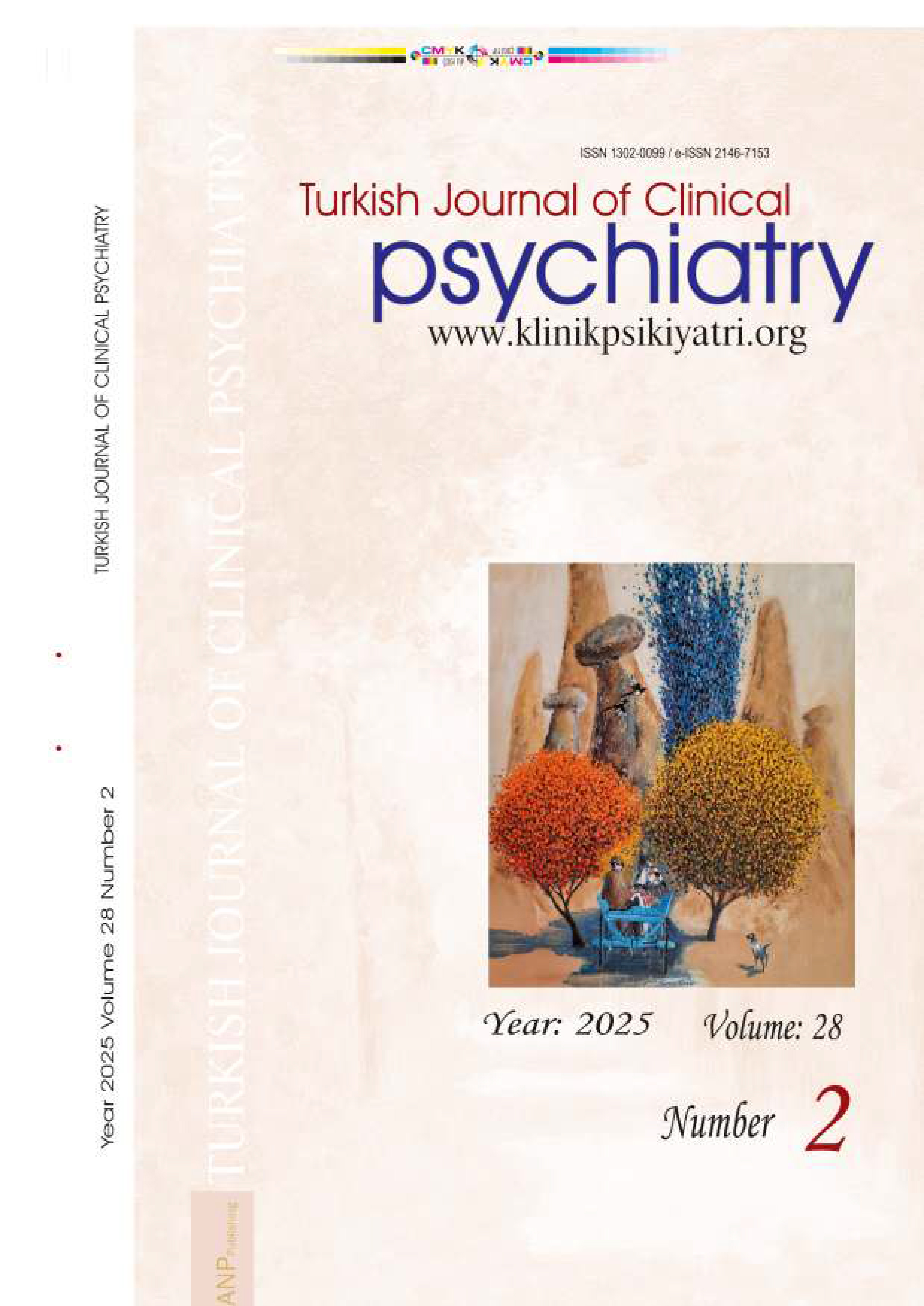





Volume: 7 Issue: 1 - 2004
| RESEARCH ARTICLE | |
| 1. | The Effects of Estrogen Replacement Therapy on Cognitive Processes in Postmenopausal Period Murat Kurt, Belma Bekçi, Sirel Karakaş Pages 5 - 16 Objective: The aim of this study was to investigate that effects of ERT on cognitive processes in healthy postmenopausal women without dementia. Method: Sixty one volunteer postmenopausal women (26 in ERT group and 35 in nonERT group) took part in the study. ERT subjects were between 41-69 years of age (mean: 53.31, s.d.: 6.60); nonERT subjects were between 45-62 years of age (mean: 52.37, s.d.: 4.20). The groups were matched for levels of education, age, menapousal type, and postmenapousal period. Cognitive processes were measured through 44 scores obtained from Wechsler Memory Scale-Revised (WMS-R), Cancellation Test (CT), Raven Standard Progressive Matrices (RSPM) and Line Orientation Test (LOT) all of which had been studied with respect to psychometric properties by Karakaş and colleagues for the Turkish culture. The tests were individully administered to the subjects by experienced testers. Results: Univariate and multivariate multifactorial techniques did not reveal significant differences between the ERT and nonERT groups. Conclusion: Some studies report positive effect of ERT on cognitive processes. In spite of the usage of different techniques of inferential statistics, the present study could not demonstrate the pervasive cognitive changes that some studies found. |
| 2. | Awareness of Sexually Transmitted Diseases and Risky Sexual Behavior Amongst Patients with Schizophrenia and Bipolar Mood Disorder Figen Karadağ, Aytül Gürsu Hariri, Jülide Kenar Pages 17 - 25 Objectives: This study aims to determine and compare both the level of information on sexually transmitted diseases and sexually risky behavior of patients with schizophrenia and bipolar mood disorders. Method: All patients were given a socio-demographic data form and a semi structured questionnaire developed by the authors on sexually transmitted diseases and risky sexual behavior. Patients with a current episode of hypomania, mania or depression, patients with a psychotic exacerbation and patients with mental retardation have been excluded. Results: The study group consists of 80 patients with bipolar mood disorder (48 female and 32 male, mean age 31.9±8.9) and 42 patients with schizophrenia (23 female and 19 male, mean age 34.1 ±9.2). It was found that 47.5% of patients were sexually active, number of sexual partners were significantly higher for patients with schizophrenia. AIDS was the most remembered sexually transmitted disease name. Patients with bipolar disorder were more likely to be aware of hepatitis B. Conclusion: Both groups had similar patterns of risky sexual behavior. Level of information on sexually transmitted diseases was not satisfactory. |
| 3. | Psychiatric Comorbidity in Chronic Daily Headache Nuray Atasoy, Tuğrul Atasoy, Aysun Ünal, Numan Konuk, Levent Atik Pages 26 - 31 Objectives: Psychiatric comorbidity in headache disorders has been studied rarely, therefore in this study we aimed to investigate the prevalence of psychiatric comorbidity in chronic daily headache. Method: We recruited 115 consecutive patients with chronic daily headache. Psychiatric evaluation of the patients was made according to Structured Clinical Interviewing for DSM-IV Axis I Disorders Clinical Version (SCID-CV). Anxiety and depression levels were scored with Beck anxiety and depression scale. Results: Chronic migraine was diagnosed in 55 patients, chronic tension type headache in 56 patients and new daily persistant headache in 4 patients. 25 patients (45.5%) with chronic migraine had psychiatric comorbidity; including major depression in 6 patients (10.9%), dystimia in 11 (20%), panic disorder in 5 (9.0%), obsessive compulsive disorder in 1 (1.8%), and generalized anxiety disorder in 2 (3.6%). 31 patients (55.4%) with chronic tension type headache had psychiatric comorbidity; including major depression in 10 patients (17.8%), dysthimia in 13 (23.2%), panic disorder in 4 (7.1%), generalized anxiety disorder in 3 (5.3%), and somatization disorder in 1 (1.7%). Medication overuse ratio was 69.5% in chronic daily headache patients. Psychiatric comorbidity ratio was significantly higher in chronic tension type headache with medication overuse patients than in patients without medication overuse (70% vs 38.5% p=0.018). Conclusion: We thought that these results demonstrate that psychiatric comorbidity is highly prevalent in chronic daily headache patients and may be a risk factor for medication overuse. |
| 4. | Psychiatric Loading in Parents of Children with Attention Deficit Hyperactivity Disorder Oya Güçlü, Murat Erkıran Pages 32 - 41 Objectives: The purpose of this study was to investigate the lifetime psychopathology according to DSM-IV criteria in mothers and fathers of children followed up with attention deficit hyperactivity disorder (ADHD). Method: The samples were consisted of the parents of 118 children with attention deficit hyperactivity disorder (ADHD) and 11 5 children with enuresis nokturna (EN). For assesment semi-structured socio demographic form, Turgay ADHD scale and SCID-I were used. Results: The rates of mood (%12.3) and anxiety disorders (%8.1) in parents of ADHD children were found statistically significantly higher than the parents of EN children (respectively %4.8, %3.5).ln parents of children with ADHD, of sixteen (%6.8) have met criteria for adult attention deficit hyperactivity disorder. %62.5 of adult ADHD were female. Comorbidies of mood disorders (%12.5) and anxiety disorders (%25) (mostly; panic disorder and obssesive compulsive disorder) were determined in ADHD adults. Conclusion: We have concluded that; the investigations of possible gender differences in familial transmission of attention deficit hyperactivity disorder and comorbid other psychiatric disorders should be planned, adult attention deficit hyperactivity disorder and comorbidities might be a distinct familial subtype so that to support this, further family and biolgical studies supposed to be conducted and also we need follow- up studies to determine if attention deficit hyperactivity disorder, the comorbid disorder or both persist over time. |
| 5. | Assessment of Anxiety, Depression and Stres Levels of Mothers of Handicapped Children Şükrü Uğuz, Fevziye Toros, Banu Yazgan İnanç Pages 42 - 47 Objectives: The aim of this study is to determine sociodemographic properties of handicapped children and to compare their mother's depression, anxiety and stres levels with that of mothers with healthy children. Method: Participant mothers were divided into two groups. All mothers of handicapped children were called patient group. This group consisted of parents of 29 mentally retarded, 26 autistic children and 25 children with cerebral palsy. Control group consisted of 89 parents having healthy. Sociodemographic properties were gathered using a student sociodemographic form. This form was used during the interview with both group of parents. Beck Depression Inventory, Beck Anxiety Inventory and 4 subscales of Holroyd's Questionnaire on Resources and Stress was administered to all mothers. Results: Beck Depression Inventory and Beck Anxiety Inventory scores of patient group was statistically higher than Beck Depression Inventory and Beck Anxiety Inventory scores of control group mothers. Also three subscale scores of Holroyd's Questionnaire on Resources and Stress was significantly higher in patient group of mothers. These subscales were dependency and management limits on family opportunities and personal burden for respondent. Conclusion: In general mothers of handicapped children reported a greater level of depression, anxiety and stres than mothers of handicapped children. It was suggested that mothers of handicapped children should be given a regular psychological support. |
| 6. | Postpartum Depression and Serum Cholesterol Level Yavuz Selvi, Rıfat İnci, Ümit Kemal Kıran, Mehmet Yücel Ağargün, Ömer Akil Özer, Buket Eryonucu Pages 48 - 50 Objectives: Onset of major depressive disorder is often related with postpartum period. DSM-IV allows that major depressive episode is specified with postpartum onset. The onset of depressive episode at the postpartum period may be associated with sudden hormonal changes. The aim of the study was to investigate relationship between postpartum depression and serum cholesterol level. Method: Fifteen depressed patients with postpartum onset and 15 depressed patients without postpartum onset were included in the study. All the patients met DSM-IV criteria. Groups were matched for age and weight. Results: The patients with postpartum onset had lower serum total cholesterol and low-density lipoprotein levels than the patients without postpartum onset. Conclusion: Our results suggest that there may be an association between postpartum depression and low serum cholesterol level. |
| CASE REPORT | |
| 7. | Two Cases of Attention Deficit Hyperactivity Disorder Diagnosed in Early Adulthood Ceyhan Balcı Şengül, Cem Şengül, Şükran Telci, Nesrin Dilbaz Pages 51 - 56 Attention deficit hyperactivity disorder which is characterized by inattentiveness overactivity and impulsivity is one of the most common disorders of childhood and adolescent affecting %3-5 of them. Recent studies show that the condition continues into adulthood higher than half percent. Although ADHD was first identified in children in the beginning of 20th century, adult ADHD was not described in the literature until 1976 when Wood and colleagues showed evidence of response to stimulants in a group of adults who presented with the same symptoms as children. ADHD in adults presents three major diagnostic problems. These are valid history of ADHD symptoms in childhood, comorbidity and presentation with unspesific features. A childhood history of ADHD is requisite for a diagnosis of adult ADHD, although full DSM-IV criteria for the childhood disorder need not be met as long as significant symptoms and impairment occurred. As individuals with ADHD become adults, the responsibility for their treatment should be transferred from child psychiatrists to psychiatrists who treat adults Unfortunately, many adult and general psychiatrists are unfamiliar with diagnosing and treating the disorder. Because of this many patients remain undiagnosed and their difficulties ascribed to lack of motivation or intelligence. We presented two cases of Adult ADHD without any comorbidity. Both of the cases have complaints of attention deficit, difficulties in concentration, impulsivity and problems in education and friendship. We discussed the two cases of Adult ADHD with recent literature. Keywords: ADHD, early adulthood, diagnose. |
| 8. | Blepharospasm, Tourette Syndrome and Obsessive Compulsive Disorder: Two Case Reports Pelin Kaplan Sayan, Volkan Topçuoğlu, Aylan Gımzal, Esat Oğuz Göktepe Pages 57 - 60 Blepharospasm is a movement disorder characterized by involuntary contractions of the orbicularis oculi muscles with continuous or intermittent eyelid closures. Obsessive compulsive symptoms are reported to be more frequent in patients with blepharospasm compared to healthy controls and patients with other movement disorders. In this paper, two cases of blepharospasm with obsessive-compulsive disorder (OCD) are presented. The assessment of the cases revealed that they had symptoms of Tourette syndrome (TS) as well as OCD. TS and OCD, especially childhood-onset OCD, can highly be seen together. Blepharospasm is the most common ophthalmic pathology in TS. The brain-imaging studies in OCD show that basal ganglia structures can play an important role in this disorder. Obsessive-compulsive behavior, which occurred after bilateral basal ganglia lesions, has been described. Blepharospasm is usually idiopathic, but some cases are associated with lesions in the brainstem or the basal ganglia. This psycho-neuro-ophtalmic combination, namely OCD, TS and blepharospasm, might be caused by the role of basal ganglia dysfunction in each of three disorders. It must be considered that TS and OCD may coexist in cases of blepharospasm and patients must be assessed in this point of view. |










